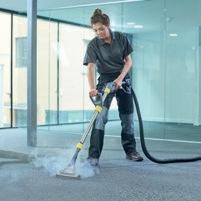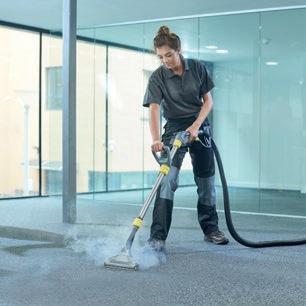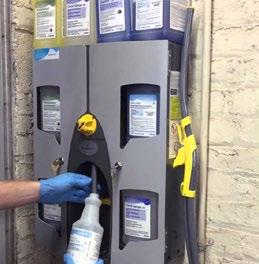THE PROFESSIONAL CLEANING & HYGIENE PRODUCTS INDUSTRY FUNDAMENTALLY SUSTAINING SOCIETY WITH PROFESSIONAL CLEANING SOLUTIONS

We all expect the public spaces in which we work, eat, socialise and travel through to be both clean and safe. And such expectations are met thanks to the work of the companies and associations in the A.I.S.E. network. The professional cleaning and hygiene industry ensures high levels of cleanliness and – where appropriate – disinfection in public spaces, hospitals and the food industry for example, reducing or eliminating contact with harmful microorganisms that lead to illness and potentially fatal infection agents.
Laundry

€0,6 billion
(e.g. industrial laundering of workwear & hospitality uniforms, hotel & hospital linens)
Building care
€1,0 billion
(e.g. floor cleaning & maintenance, washroom services, window care, surface disinfection)


Food & beverage
€1,8 billion
(e.g. food processing, storage & transport, dairy milking equipment)
Over 400 companies, 85% of which are SMEs, in the A.I.S.E. network provide professional cleaning and hygiene solutions in Europe.
THIS INDUSTRY DIRECTLY BENEFITS PEOPLE IN MANY WAYS:
Protects our health with hygiene and cleanliness in public spaces
Secures patient safety in healthcare environments

Prevents infection through good hygiene practices
Makes our lives more pleasurable and satisfying
Adds to our sense of wellbeing
Facilitates convenient and modern lifestyles
Technical cleaning
€1,5 billion
(e.g. metal cleaning, water cooling, nuclear plant decontamination)
Healthcare
€1,9 billion
(e.g. hospitals, disinfection of surgical instruments, nursing homes)

Kitchen & catering
€1,9 billion
(e.g. restaurants, industrial dishwashing)
Maintains the durability of goods
Increases productivity for companies
Protects investments in brands
Contributes to sustainability
THE PROFESSIONAL CLEANING & HYGIENE PRODUCTS INDUSTRY
17.3% 11.5% 21.7% 20.7% 6.5% € 8,7 billion Market value of sector 22.3% © A.I.S.E. 2023
1
* Source: A.I.S.E. national associations’ data in 2022
A KEY CONTRIBUTOR TO PUBLIC HEALTH & HYGIENE
Hygiene is the foundation for health and is of paramount importance in the 21st century. This has become critically clear during the coronavirus pandemic, when our industry had a crucial role in ensuring that essential products were available and supplied rapidly not only in the healthcare sector, but also to the food and agricultural industry for example.
Cleaning
Cleaning is the mechanical or chemical removal of dirt and soil from the human body, an inanimate object or an area. Normally, cleaning with soap or detergent followed by rinsing with water is adequate to remove visible dirt and allergens. Cleaning, especially cleaning followed by rinsing reduces the number of microbes on hands, surfaces and fabrics.
The need for hygiene
• Increasing resistance to antibiotics
• Increasing speed at which existing and new diseases spread
Disinfection
Disinfection is the targeted use of a biocidal product to help prevent the spread of infection in situations where there is high risk of transmission of harmful microbes e.g. when someone is vulnerable to infection. Disinfectants prevent the spread of infection by deactivating or killing harmful organisms.
420,000 people die from food poisoning each year in the world
➤ Preventable through better hygiene standards
Source:EuropeanCentreforDiseaseContro l
Hygiene
Hygiene is the practice through which people maintain or promote good health by breaking the chain of infection. All practices that make people and their surroundings (e.g. surfaces or hands) clean, and when needed disinfected, contribute to hygiene. Other hygiene measures include keeping a certain distance from people who are infected and wearing masks.
• Increasing fear of chemicals
• Less understanding of the need for hygiene
Good hand hygiene breaks the chain of infection
THE CRITICAL ROLE OF DISINFECTANTS
Disinfectants are products that contain active biocidal substances with antimicrobial properties. Disinfectants falls under the biocides legislation, and are essential in our everyday lives to protect our health by preventing the spread of harmful microbes. The COVID-19 pandemic highlighted the essential need for products such as hand and surface disinfectants to keep our working and living environments safe and clean.
Disinfectants are essential for
• Food manufacturing and a safe and healthy food chain
• Veterinary hygiene and animal welfare
• Disinfection in medical and healthcare facilities

• Insect and pest control
• Less time for cleaning and disinfection
• Prevention of infection not a priority in budgets
37,000 patients die each year due to hospital acquired infections in Europe

Source:EuropeanCentreforDiseaseContro
More than
25% of hospital acquired infections are preventable through intensive hygiene
Source:EuropeanCentreforDiseaseContro l
THE
& HYGIENE PRODUCTS INDUSTRY
PROFESSIONAL CLEANING
2 © A.I.S.E. 2023
A HIGHLY DIVERSE SECTOR WITH TAILOR-MADE CUSTOMER SERVICE
This sector is characterised by the presence of many SMEs which deliver targeted cleaning solutions. With their specialist knowledge and proximity to their clients, they are ideally placed to create and supply niche products for customers with unique operational demands in a wide variety of institutional and industrial situations.
The specificities of this sector
• 85% of companies in Europe are SMEs
• Delivery of tailor-made cleaning & hygiene solutions
• Specialist knowledge and proximity to client
• Supply of niche products
• Broad variety of customers with unique operational demands
• Training is an integral part of customer service
• Different distribution and sales mode from homecare products
Examples of cleaning applications
ENSURING CLEANING EFFICIENCY IN THE DAIRY INDUSTRY
In a dairy company that undertakes transformation, production and delivery of finished dairy products, a professional cleaning company can work with the customer to design and install the cleaning in place (CIP) units and the belt lubrication system on the bottle conveyor, using associated chemical products.

Snapshot of a cleaning in place (CIP) guidance document provided by the detergent supplier, to support a safe and efficient automated cleaning process for the interior surfaces of pipes, filters and other equipment.

• Vast majority of sales done through tenders
• Worker friendly dosing and dispensing equipment
• Safety and sustainability are fundamental principles
SUPPLYING HAND, SURFACE AND LAUNDRY DISINFECTANTS
The hands are a critical contact point most often responsible for the spread of harmful microbes. Washrooms in public buildings or in professional kitchens require dispensers for hand soaps packed in a dedicated system that fits the particular dispenser and limits contact with the cleaning product.

The use of disinfectants to kill harmful micro-organisms such as Escherichia coli on hands and surfaces is crucial. The A.I.S.E. product portfolio includes biocides such as hand, general surface and laundry disinfectants which are subject to rigorous legislative compliance.

THE PROFESSIONAL CLEANING & HYGIENE PRODUCTS INDUSTRY
1
2
3 © A.I.S.E. 2023
MAINTAINING FLOORS IN PUBLIC SPACES

Floor care requires a range of products to cope with the different floor surfaces (carpet, wood, tile, marble, rubber, etc.) and applications such as cleaning, polishing and stripping. Floor care products include floor polishes and waxes, restorers, polish and wax removers, and raw materials such as waxes and acrylic emulsions that protect and restore surfaces in public buildings.

As well as the appropriate product, a range of specialist machines (scrubbers, high or low speed polishing single disk machines, vacuum cleaners) and utensils (mops, lamellos, etc.) are required, together with trained personnel, for an optimal result.
CLEANING MEDICAL DEVICES

Medical devices e.g. endoscopes cannot be cleaned in normal sterilisation machines. Professional detergents use enzymes which function in low concentration with low temperature and mild pH to ensure devices are safe to use for each patient.

Products that are used for the cleaning and disinfection of medical devices now fall under the scope of the EU’s Medical Devices Regulation. IHO and A.I.S.E. have published Guidance for the industry to support companies correctly implement the legislation.
SECURING PATIENT SAFETY

Disinfectants play a crucial role in securing the safety of hospital patients, from the cleaning of their room to the disinfection of the medical devices and laundering of operating theatre gowns and hospital linens. Keeping patients and medical personnel safe is a highly complex task.
In industrial laundering, work clothes, bed linen, mops, etc. are washed in large batches to optimise the washing processes and tailor the detergent chemistry to the specific requirements.


ENSURING THE SAFETY OF THE FOOD CHAIN
Food processing industries must meet strict hygiene regulations to ensure the safety of the food chain, and ultimately the consumer. Contamination from harmful viruses or bacteria is avoided through the appropriate application of cleaning agents and disinfectants that are subject to rigorous European standards, protocols and food safety management systems.
Milk quality is influenced by hygiene before, during and after the milking process. The importance of good barn hygiene and control is essential for a well-functioning and safe dairy farm.

THE PROFESSIONAL CLEANING & HYGIENE PRODUCTS INDUSTRY
4
6
5
3
4 © A.I.S.E. 2023
DRIVING HIGH STANDARDS OF SUSTAINABILITY
This industry is a leader on the sustainability profile of its products and processes developed over years, and contributes to the ambitious EU and UN environmental agenda through industry innovation and multiple voluntary initiatives.
Highly concentrated products

Companies optimise resources with highly concentrated products. This is essential for sustainability and is a key strength of this industry, resulting in substantially lower CO2 emissions across the life cycle of the product, from supply and manufacturing to packaging and delivery.
Controlled dosing
The industry’s state of the art dosing equipment ensures the correct amount of detergent for each application, leading to optimal performance, preventing spillage and waste and limiting contact with cleaning products.

Over-dosing leads to an increased use of chemicals, water, heat and energy, whereas under-dosing means an unsatisfying result and re-cleaning which has an additional environmental burden.
Sustainable cleaning
Lower environmental impact
• Optimal use of resources
• Less water
• Less packaging
• Less transport
& transport
Corporate action and voluntary industry initiatives go hand in hand, and complement each other. The A.I.S.E. Charter for Sustainable Cleaning is a voluntary initiative that encourages the whole industry to pursue ambitious sustainability improvements across the whole lifecycle. With independent verification and KPI reporting, it drives measurable progress on a number of sustainability criteria.
53 professional cleaning companies are currently Charter members. As part of the Charter, Advanced Sustainability Profiles (ASP) are required for product groups such as professional building care products, covering specifics such as packaging weight; recyclability, reusability, compostability; dosing systems; training and end user information; and cleaning performance. More on www.sustainable-cleaning.com
Balancing resources
Since 2006, Charter members have achieved:
• 55% less CO2 emissions per tonne of production
• 43% less energy use per tonne of production
• 17% less packaging
The professional cleaning process is a sophisticated balance of four parameters. To ensure optimal cleaning and hygiene performance, as well as sustainable products and processes, the circle must remain balanced: if one parameter is reduced, another must be increased. A change in the chemical formulation of a product, for example, may be compensated with increased temperature, more rinsing or a longer programme.
THE PROFESSIONAL CLEANING & HYGIENE PRODUCTS INDUSTRY
formulationand Chemistery i n gred ientsofaproduct ofthecleaningTemperatureprocess mechanicalforcee.gAction a b r as ion, highpressure ofthecleani n g Timeprocess
5 © A.I.S.E. 2023
Controlled dosing = optimal performance + savings in chemicals, water, energy, packaging
PRIORITISING SAFE USE OF PRODUCTS
Professional cleaning products and services providers have an important legal responsibility to provide accurate, upto-date safe use information to customers so that they can be informed about the precautions required in handling and storing products. The Safety Data Sheets and Product Information Sheets are the standardised way to do this. Companies will often go further, providing environmental safety information and advice on cleaning techniques and training of personnel, as well as working closely with their customers to develop and document their hygiene routines and procedures, putting in place targeted occupational health and safety measures to address a customer’s specific situation and helping them to conform to applicable legislation.
Communicating safe use to end users
Professional cleaning and hygiene companies in Europe have been proactively communicating safe use information to their customers for decades and, in partnership with A.I.S.E., pioneered the development and use of safety pictograms over 20 years ago, a practice that has since spread to the consumer products side of the industry.

62 SUMIs
Bedrijfsdeskundigen gebruiken
SUMI's om instructies voor de werkplek te maken
Safe Use of Mixtures Information documents (SUMIs) are another valuable tool developed by A.I.S.E. that offers manufacturers supplying to the industrial and professional cleaning industry a standardised way to provide clear and accessible information to cleaners using the products on how to use them safely.
A.I.S.E. guidance for the industry
A.I.S.E. has an important role in guiding the industry in the correct interpretation and implementation of EU legislation, as well as ensuring that all actors in the supply chain have the necessary information to comply with legislative requirements and thereby ensure the safe use of products. These two examples refer specifically to the professional cleaning sector.
Use Maps & Guidance for ingredient registration
A.I.S.E. compiles information on all uses of a substance in products to ensure that REACH risk assessment is appropriate and accurate - a good quality registration needs to be based on up-to-date and reliable information on how products are actually used. A.I.S.E. assists the supply chain with the publication of its Use Maps, which cover the vast majority (>80 %) of the products’ uses and applications. To accompany the Use Maps, A.I.S.E.’s REACH Guidance supports suppliers, formulators and end-users in the supply chain to generate and communicate safe use information for cleaning and maintenance products.
Industry Guidance on Medical Devices
This guidance is a collaboration between experts from IHO the German national association for professional cleaning products, and A.I.S.E. and aims to support our industry in implementing the EU Regulation on Medical Devices (MDR). The guidelines are of particular relevance for companies manufacturing products that are used for the cleaning and disinfection of medical devices, since these now fall under the scope of the MDR.

THE PROFESSIONAL CLEANING & HYGIENE PRODUCTS INDUSTRY
A.I.S.E. APPLICATION PICTOGRAMMES FOR PROFESSIONAL CLEANING To download the full set of pictogrammes, visit www.aise.eu/professionalcleaning Guidance safe use of detergent and maintenance products under REACH A practical way to generate and communicate safe use information for cleaning and maintenance products under REACH Guidance for suppliers, formulators and end-users n detergents and maintenance products supply chain. The provided in this Guidance upporting suppliers of detergent products and rs and Occupational Health institutional cleaning companies the under REACH. The information provided this document information purposes only. the best of our knowledge subject to changes. Compliance with individual company resp A.I.S.E. and NVZ assume no use made by any person having access to this information. In case any user of this identify an mistake amended (s)he invited to inform accordingly. A.I.S.E. / IHO GUIDELINES ON REGULATION (EU) 2017/745 ON MEDICAL DEVICES 2021 For more information go to www.aise.eu/professionalcleaning 6 © A.I.S.E. 2023
























